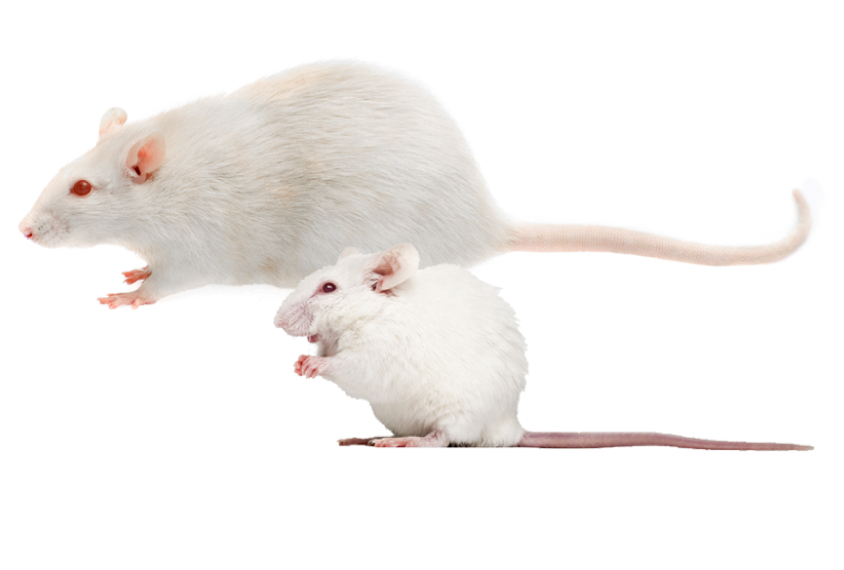
Elena Butinova, Eric Isselee/Shutterstock.com
THIS ARTICLE IS MORE THAN FIVE YEARS OLD
This article is more than five years old. Autism research — and science in general — is constantly evolving, so older articles may contain information or theories that have been reevaluated since their original publication date.
The same autism-linked mutation can lead to dramatically different behaviors in rats and mice. Researchers presented the unpublished findings in two posters today at the 2015 Society for Neuroscience annual meeting in Chicago.
The findings point to some advantages of experimenting with rats — which are smarter and more social and have larger brains than mice do. But they also highlight the danger of relying on behavior changes in a single species when testing potential autism drugs.
Four years ago, Sigma Life Science released seven rat models of autism, to great fanfare, at the 2011 Society for Neuroscience Annual Meeting, in Washington, D.C. These rats lack one or both copies of any of seven autism-linked genes: FMR1, NLGN3, MeCP2, NRXN1, CACNA1C, PTEN and mGluR5. Researchers have since engineered rats missing the SHANK2 and SHANK3 genes.
Researchers welcomed these models because rats have more complex social behaviors than mice do. For instance, mice don’t play at all, but juvenile rats revel in roughhousing. Many of the mutant rats are more hesitant to engage in this rough-and-tumble play than typical rats are.
“The behaviors that are displayed by mice are not nearly as complex as compared to rats,” says Rodney Samaco, assistant professor of molecular and human genetics at Baylor College of Medicine, in Houston, who presented the findings on a MeCP2 rat at a poster session Tuesday.
Rat Rett:
Samaco is looking at behaviors in female rats that lack MeCP2, a gene on the X chromosome that is mutated in Rett syndrome, an autism-like developmental disorder. Boys with Rett syndrome usually do not survive, because with only one X chromosome, they have no backup copy of the gene. Still, researchers have traditionally studied male mice with the mutation because they show symptoms much earlier than females do.
But female rats missing one copy of MeCP2 may be a better model. These rats develop symptoms earlier than female mice do — for example, showing problems with motor skills two weeks earlier than mice. Rats also seem hesitant to play with their cage-mates and, remarkably, show signs of the same regression seen in girls with Rett syndrome around 2 years of age.
To test regression, researchers give mice a shell-covered seed. Both mutant and typical rats initially take about 100 seconds to learn how to open the seed. Over time, however, normal rats get much faster, whereas the mutants actually take longer.
The researchers also measured gene expression in the brains of male rats lacking MeCP2 as well as controls. They did a parallel experiment in mice. MeCP2 is known to regulate the expression of thousands of other genes. They found that each type of rodent has a distinct set of abnormally regulated genes. For example, there are 636 genes expressed at lower levels in MeCP2 mutant rats than in controls, and 2,184 for mice. Only 299 genes show lower expression in both species.
Common ground:
To find molecular pathways underlying symptoms, researchers should focus on these shared genes, says Samaco. Similarly, the behaviors to watch are those shared by rats and mice with the same mutation, says Surabi Veeraragavan, an instructor in human and genetic medicine at Baylor College of Medicine, who presented another poster today.
Comparing a range of behaviors across rats and mice lacking one copy of NRXN1 or MET and both copies of CNTNAP2, Veeraragavan found that hyperactivity was the most consistent between species. Both NRXN1 and CNTNAP2 mice and rats showed hyperactivity, and the MET mice and rats showed no difference.
In contrast, CNTNAP2 mice and rats showed dramatically different social behavior. CNTNAP2 mice show little interest in another mouse, but the rats play more than typical rats do. This may be in part because the CNTNAP2 mutant rats are hyperactive and so are more likely to encounter other rats to play with.
Still, the findings amount to a warning against relying too heavily on social behavior when evaluating autism drugs in rodents, says Laura Mamounas, program director of the National Institute of Neurological Disorders and Stroke, who was not involved in the study.
“For drug screening, we need to pick phenotypes that are highly conserved in different species so that we are more confident that it would also be conserved in humans,” she says. “Social behavior is all over the map, and I think we need to learn from that.”
Brain imaging might also help identify consistent autism-linked characteristics in rodents that match up with those in people, says Jacob Ellegood, a research associate at the Mouse Imaging Centre, in Toronto. Ellegood has scanned the brains of 27 different mouse models of autism and found that brain structures vary among them. Rats have bigger brains than mice, which could increase the accuracy of the readings. To image rats, Ellegood and his colleagues would have to build a bigger brain scanner, but plans are in the works. “I want to scan them all,” he says.
For more reports from the 2015 Society for Neuroscience annual meeting, please click here.
By joining the discussion, you agree to our privacy policy.